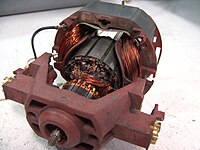
Photo from wikipedia
The detection of lift-off variation presents a significant challenge in many eddy current testing (ECT) applications, where it is often considered an undesirable signal. To address this issue, this article… Click to show full abstract
The detection of lift-off variation presents a significant challenge in many eddy current testing (ECT) applications, where it is often considered an undesirable signal. To address this issue, this article proposes a novel four-coil excitation sensor, which can effectively suppress the lift-off effect when detecting defects of varying depths in planar structures. The proposed sensor design leverages opposite excitation directions between any two arbitrary adjacent excitation coils, which can effectively cancel out the lift-off signal due to a defect-free plate. However, this four-coil excitation design has an angular sensitivity—i.e., different signal responses for different angles between the same defect and the sensor. This angular sensitivity will cause trouble to identify the depth of defects without knowing the angle prior. To overcome this challenge, this study introduces deep learning (DL) models as a potential solution. Signals representing different defect depths and angles between the sensor and the defect are acquired using an experimental platform in our laboratory. The real and imaginary parts of the induced voltage on the receiver coil labeled with depths and angles are utilized to train a 1-D convolutional neural network (1-D CNN) model, in which different convolution kernel sizes are used to extract more information and speed up convergence. The high performance of the proposed structure of 1-D CNN was compared with the convolutional long-short-term memory (LSTM) model, recurrent neural network (RNN) model, LSTM + RNN model, and ResNet18 model. The proposed 1-D CNN model not only achieves good performances with a higher accuracy of 99.8% but also requires a smaller model size and less computational time.
Journal Title: IEEE Transactions on Instrumentation and Measurement
Year Published: 2023
Link to full text (if available)
Share on Social Media: Sign Up to like & get
recommendations!